Mangusta Resurrection
How to take a thoroughly trashed tjet, and make it into a Fray style racing body
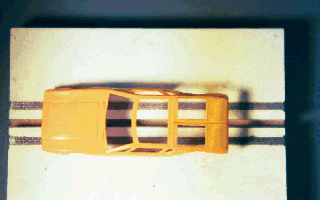
For this project we have a Aurora deTomaso Mangusta. The car was dremeled out inside the body and
most of the rear end had been cut away, the body mounts gone, there are holes in the front for mounting on an Aurora
AFX specialty chassis. I dremeled away on this car back in the mid-70's, to race in a club that
required hard bodies, but allowed dremeling. I finally convinced the track owner that Lexan bodies
are the way to go for racing, so that this kind of carnage could be avoided.
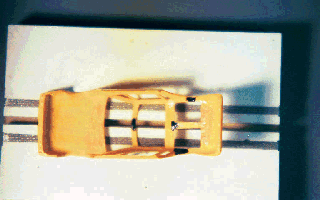
The body was broken into two sections and the very fragile "A" piller was broken too. The first
step was to "Black Max" the broken pieces together. "Black Max" is Loctite 380 industrial adhesive,
It is not normally found except at industrial adhesive suppliers and also most shops catering
to HO magnet car racing. Slottech and Wizzard carry it, it is expensive, about $7-$8 for a small tube.
You could subsitute any superglue, but I would suggest backing that with epoxy as well, and it still
wouldn't have the strength of "Black Max." Let this dry thoroughly before proceeding.
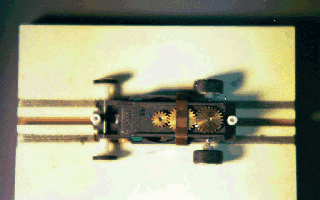
You want to have your chassis setup, with the tires/wheels that you intend to race with. This is a
stock Hong Kong Tjet, with Wizzard tires and wheels. Since the body had the mounting tubes removed,
we will replace them with plastic tubing, available at most hobby shops. Before cutting the tubing,
use a Tjet mounting screw to form the threads in the tubing, screw it in and out a couple of times
to make sure it screws in properly. Then cut the tubing to clear the driven gear on the rear mount. Do the same procedure
to cut a piece of tubing for the front, make sure is tall enough to provide clearance over the gear
plate rails. Some rules allow for cutting of the gear plate rails, others do not. Check beforehand on
your racing rules.
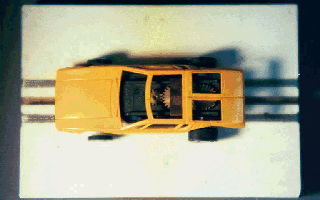
Sit the body on the chassis. You may have trim the mounting tubes, or change the angle to get the right fit.
Spend some to time to get it setting straight. Put a dot of superglue on the mounting tubes
and position the body. To get good handling, it's usually a good idea to put your wheels out, as far as the rules permit,
this is usually 1"5/16ths for most clubs. As you can see, if you put a tjet body on a chassis
with the wheels this wide, they stick outside the body too far for good looks. I never like my GT cars to look like open wheelers! We will fix
that problem shortly.
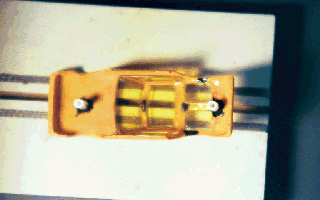
Put a good coating of "Black Max" around the posts and let it dry thoroughly. You could subsitute
epoxy for this step.
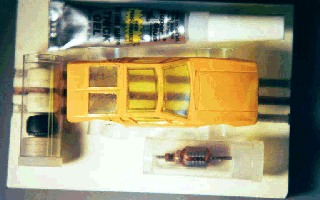
Now we will make the flares, that will really make the body look tough and cover the wide track.
I use the tire/armature tubes that most HO racing suppliers use, these are from Wizzard. Cut four
slices from the tube, about 3/8" to 1/4" depending on how wide the particular body you are using is.
In this case I'm using Future glue, a superglue gel, from Target. Put the glue around the wheel
wells and position the cut tubing. Do two at a time, so you can hold it in position until it sets.
If you have uncut wheelwells, they would have to be radiused before this step to match the tubing
diameter. Don't do this to an uncut Aurora Tjet! I'm only doing this procedure to cars that have been badly
damaged in racing or to Playing Mantis Tjet bodies.
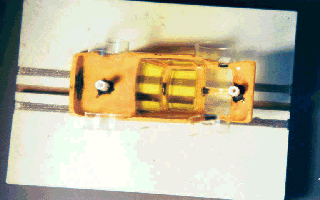
Let the tubing thoroughly dry before proceeding.
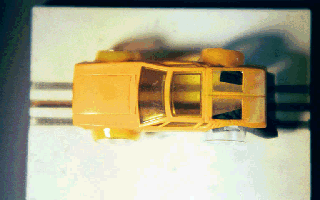
Trim the tubing to the desired width and shape. Sit the body on the chassis to check for clearance
and proper width to cover the tires. To make the actual flares I used a quick dry epoxy (sets in 90 seconds!)
from Target. I've found I can do only three flares before the epoxy starts to set, so you might
want to use 5 minute epoxy or just do two flares at a time. I mixed up some Testor's hobby paint, to approximate
the original butterscotch color and mixed the paint into the epoxy. This doesn't seem to affect the
strength of the epoxy and can look like the orginal plastic material. Use a toothpick to run the epoxy around the wheelwells to the desired shape.
If you don't want to paint the car, the paint/epoxy combination can make a sharp looking car, I've done several black PM bodies in this manner and
they came out well. If you are painting the car anyway, it's not necessary to mix paint with epoxy. On this car the lower
part of the rear end had been chopped away, so I'm using electrian's tape to provide a form for the rear end and apply
the epoxy mix over it to restore the rear end. I use the same technique to add a front spoiler.
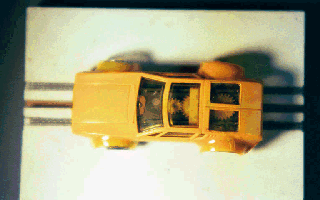
Use a pair on manicure scissors and your dremel to get the final shape right, after the flares are dry of course!
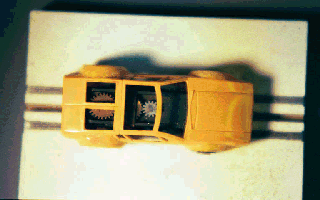
Here is the car ready to be painted, I decided that an Italian car should be Red and the while butterscotch was
fine for a street car but not a racer.
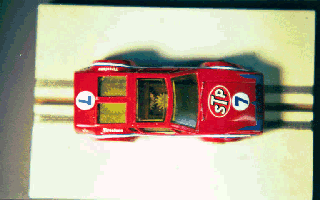
The car is painted with Plasti-kote "Odds N Ends" Insignia Red spray paint. The stripes, numbers, and meatballs were cut from
Pactra's Trim Tape pin stripes, around $5 at your hobby shop. I give it two light coats of Future floor wax to protect the finish and decals.
Now this Mangusta is ready to compete at the Fray, Roman's or the Paperboy...whereever fast Tjets gather to race.
|










